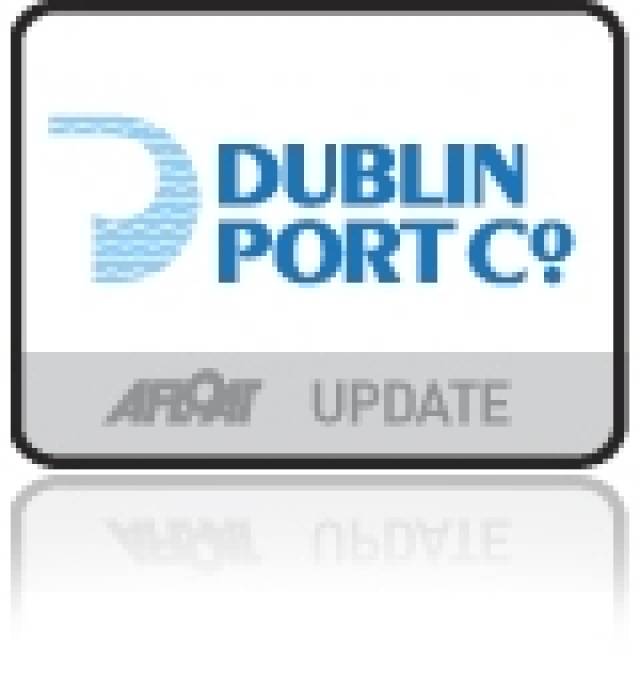#dublinport – Dublin Port Company today published trade statistics for 2014 which show a record year for trade at Dublin Port, with growth year-on-year of 7.0%. The stats follow a weekend interview with Dublin Port Company Chief Executive, Eamonn O'Reilly who mapped out the future for Ireland's major shipping port.
Total throughput for 2014 was 31 million gross tonnes with 7,108 ship arrivals in the year, bringing the port's activity back to the record levels of 2007.
Imports in 2014 were over 18 million gross tonnes, while exports exceeded 12 million gross tonnes, representing increases of 6.3% and 8.0% respectively on 2013 trade levels.
The recovery in the Port's trade has been export-led with volumes of exports 1.6 million gross tonnes greater than in 2007. On the import side there has been continuing recent growth (driven by improving domestic consumption) and this has pushed Dublin Port's overall volumes ahead to equal previous record levels of 31 million gross tonnes.
High levels of growth were recorded for trade vehicles, mostly new cars destined for dealerships around the country. The port received 81,169 trade vehicles in 2014, up 33.3% on the previous year. To accommodate the growing number of trade vehicles entering the port, Dublin Port opened a new €3.4 million 4.2 hectare trade car terminal at East Wall Road in October 2014. This new terminal can cater for 2,500 vehicles at a time.
There was particularly strong growth in the unitised modes with Ro-Ro trailers ahead by 7.9% and Dublin Port's Lo-Lo container businessahead by 9.4%. In 2014, the Ro-Ro sector achieved strong results with 821,876 units while Lo-Lo containers finished the year at 565,698 twenty foot equivalent units (TEU). The strong performance of the unitised business highlights Dublin Port as the island's port of choice for both Ro-Ro and Lo-Lo services.
SUMMARY OF TRADE STATISTICS
|
2014 |
2013 |
|
|
Throughput (‘000 gross tonnes) |
30,849 |
28,840 |
|
18,358 |
17,271 |
|
12,491 |
11,569 |
|
Ro-Ro (freight units) |
821,876 |
761,958 |
|
Lo-Lo (TEUs) |
565,698 |
516,872 |
|
Ferry Passengers |
1,710,275 |
1,607,987 |
|
Tourist Vehicles |
462,215 |
428,468 |
|
Trade Vehicles |
81,169 |
60,905 |
On the tourism side, 1.7 million ferry passengers travelled through the port in 2014, representing a 6.4% increase on last year and placing Dublin Port on a par with major airports including Cork and Shannon. In addition, 2014 was a strong year for the port's cruise business with 140,000 visitors on 86 cruise ships.
Eamonn O'Reilly, Chief Executive, Dublin Port Company, said: "2014 was an exceptional year for Dublin Port with a 7.0% increase in cargo volumes on top of the 3.0% we saw in 2013. The port is now back to the record levels of trade recorded in 2007 with every prospect of continued strong growth in the years ahead.
"During 2014, we saw strong increases right across our main business areas, from imports and exports to trade vehicle and ferry passenger numbers. We expect growth to continue into 2015, with importers and exporters choosing to do business through Dublin Port where they benefit from direct access and frequent services to their main markets.
"Dublin Port Company is committed to sustainable investment in port infrastructure and services including the longer, deeper berths envisaged in our Alexandra Basin Redevelopment Project. These will accommodate the larger ships of the future carrying increased cargo volumes and greater numbers of passengers. This type of investment will allow Dublin and the wider economy to prosper by ensuring that Dublin Port is ready to facilitate the future trading needs of its customers and the country as a whole.
"Having completed major investments during 2014 including the new €3.4 million trade car terminal and with the development of the Alexandra Quay Container Terminal nearing completion, we are looking forward during 2015 to commencing the Alexandra Basin Redevelopment Project which the EU is already supporting under its TEN-T infrastructure investment programme."
































































